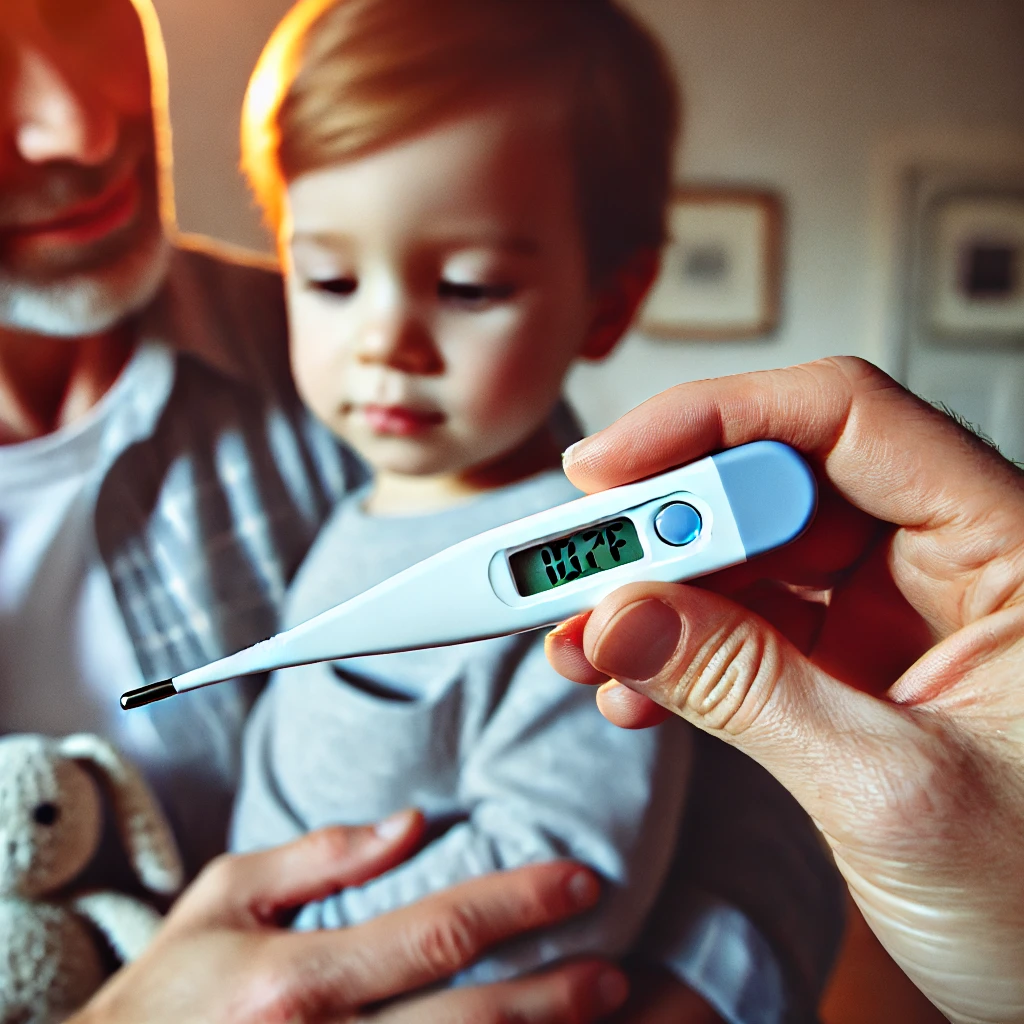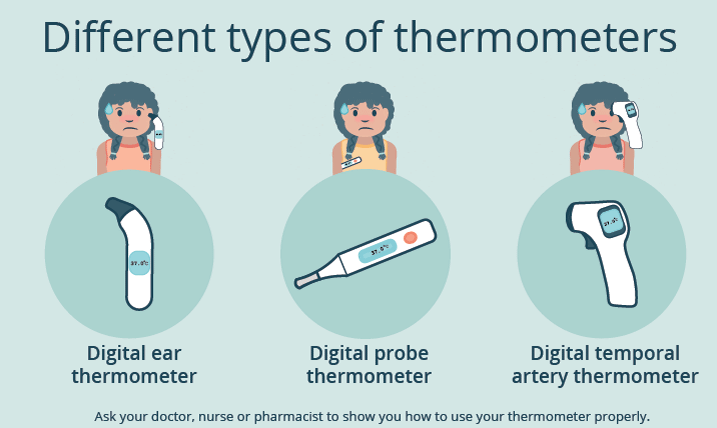
June 6, 2025
The Role of Probiotics in Child Health
ताप म्हणजे काय आणि तो घरी कसा हाताळायचा?

Introduction
Fever is one of the most common symptoms that worry parents when their child falls sick. While fever itself is not a disease, it is often a sign that the body is fighting off an infection. Knowing how to measure fever correctly and when to take action can help parents manage the situation better and decide when to consult a doctor.
परिचय
ताप हे सर्वात सामान्य लक्षणांपैकी एक आहे जे पालकांना चिंता करतात जेव्हा त्यांचे मूल आजारी पडते. ताप हा एक आजार नसला तरी, शरीर संसर्गाशी लढा देत असल्याचे अनेकदा लक्षण असते. ताप कसा मोजावा आणि केव्हा कारवाई करावी हे जाणून घेतल्याने पालकांना परिस्थिती चांगल्या प्रकारे व्यवस्थापित करण्यात आणि डॉक्टरांचा सल्ला कधी घ्यायचा हे ठरवण्यात मदत होऊ शकते.
What is Fever?
A fever is a temporary increase in body temperature, often due to an underlying infection. It is a natural defense mechanism that helps the body fight off bacteria and viruses. In children, a normal body temperature ranges from 97°F (36.1°C) to 100.4°F (38°C). When the temperature rises above 100.4°F (38°C), it is considered a fever
ताप म्हणजे काय?
ताप हा शरीराच्या तापमानात होणारी तात्पुरती वाढ आहे, अनेकदा अंतर्निहित संसर्गामुळे. ही एक नैसर्गिक संरक्षण यंत्रणा आहे जी शरीराला जीवाणू आणि विषाणूंशी लढण्यास मदत करते. मुलांमध्ये, शरीराचे सामान्य तापमान 97°F (36.1°C) ते 100.4°F (38°C) पर्यंत असते. जेव्हा तापमान 100.4°F (38°C) च्या वर वाढते तेव्हा त्याला ताप समजला जातो.
Why Does Fever Occur?
Fever occurs when the body’s immune system reacts to foreign invaders, such as viruses, bacteria, or other pathogens. By raising the body’s temperature, the immune system creates a less favorable environment for these invaders, helping to eliminate them more effectively.
ताप का येतो?
जेव्हा शरीराची रोगप्रतिकारक शक्ती व्हायरस, बॅक्टेरिया किंवा इतर रोगजनकांसारख्या विदेशी आक्रमणकर्त्यांना प्रतिक्रिया देते तेव्हा ताप येतो. शरीराचे तापमान वाढवून, रोगप्रतिकारक शक्ती या आक्रमणकर्त्यांसाठी कमी अनुकूल वातावरण तयार करते, त्यांना अधिक प्रभावीपणे दूर करण्यात मदत करते.

How to Measure Fever with a Thermometer
Measuring your child’s temperature accurately is crucial to understanding the severity of the fever. There are different types of thermometers available:
थर्मामीटरने ताप कसा मोजायचा?
तापाची तीव्रता समजून घेण्यासाठी तुमच्या मुलाचे तापमान अचूकपणे मोजणे महत्त्वाचे आहे. विविध प्रकारचे थर्मामीटर उपलब्ध आहेत:
1.डिजिटल थर्मामीटर: हे सर्वात सामान्यपणे वापरलेले आहेत आणि द्रुत आणि अचूक वाचन प्रदान करतात. ते तोंडी, गुदाशय किंवा बगलेखाली वापरले जाऊ शकतात.
2.इअर थर्मोमीटर: मोठ्या मुलांसाठी योग्य, कान थर्मोमीटर जलद वाचन देऊ शकतात परंतु लहान मुलांसाठी ते तितके अचूक असू शकत नाहीत.
3.कपाळ (टेम्पोरल आर्टरी) थर्मामीटर: हे वापरण्यास सोपे आणि गैर-आक्रमक आहेत, ज्यामुळे ते मुलांसाठी एक चांगला पर्याय बनतात. तथापि, ते डिजिटल थर्मामीटरपेक्षा किंचित कमी अचूक असू शकतात.
4.पारा थर्मोमीटर: थर्मामीटर तुटल्यास पारा एक्सपोजरच्या जोखमीमुळे यापुढे याची शिफारस केली जात नाही.
Steps to Measure Fever Using a Digital Thermometer:
डिजिटल थर्मामीटर वापरून ताप मोजण्यासाठी पायऱ्या:
तोंडी पद्धत: मुलाच्या जिभेखाली डिजिटल थर्मामीटर ठेवा आणि त्यांना तोंड बंद करण्यास सांगा. थर्मामीटरने बीप होईपर्यंत आणि तापमान प्रदर्शित होईपर्यंत प्रतीक्षा करा.
काखेची पद्धत: मुलाच्या काखेत थर्मामीटर ठेवा आणि हात शरीरावर दाबून ठेवा. बीपची प्रतीक्षा करा आणि तापमान वाचा.
गुदाशय पद्धत (लहान मुलांसाठी): पेट्रोलियम जेलीने थर्मामीटरची टीप वंगण घालणे आणि मुलाच्या गुदाशयात हलक्या हाताने सुमारे 1 इंच घाला. ते बीप होईपर्यंत ते जागेवर धरा आणि नंतर तापमान वाचा.
When to Administer Medicine for Fever
Administering fever-reducing medication depends on the child’s age, the severity of the fever, and any accompanying symptoms. Here are some guidelines:
तापासाठी औषध कधी द्यावे
ताप कमी करणारी औषधे देणे हे मुलाचे वय, तापाची तीव्रता आणि सोबतची लक्षणे यावर अवलंबून असते. येथे काही मार्गदर्शक तत्त्वे आहेत:
लहान मुलांसाठी (0-3 महिने): जर तापमान 100.4°F (38°C) पेक्षा जास्त असेल तर, त्वरित वैद्यकीय मदत घ्या.
लहान मुलांसाठी (3-6 महिने): जर ताप 100°F (38.7°C) च्या वर असेल आणि मूल चिडचिड, अस्वस्थ किंवा सुस्त असेल तर बालरोगतज्ञांचा सल्ला घ्या.
मुलांसाठी (6 महिने आणि त्याहून अधिक): ताप 100°F (38.7°C) पेक्षा जास्त असल्यास आणि मुलाला अस्वस्थता असल्यास ऍसिटामिनोफेन (टायलेनॉल) किंवा आयबुप्रोफेन (ॲडविल) द्या. नेहमी लेबलवरील डोस सूचनांचे अनुसरण करा किंवा सल्ल्यासाठी आपल्या बालरोगतज्ञांचा सल्ला घ्या.
Home Management of Fever
तापाचे घरगुती व्यवस्थापन
हायड्रेशनची खात्री करा: तुमच्या मुलाला भरपूर द्रवपदार्थ जसे की पाणी, ओरल रिहायड्रेशन सोल्यूशन्स किंवा स्वच्छ मटनाचा रस्सा हायड्रेटेड राहण्यासाठी प्रोत्साहित करा.
हलके कपडे घाला: जड कपडे किंवा ब्लँकेट टाळा; त्याऐवजी, तुमच्या मुलाला हलके, आरामदायक कपडे घाला.
विश्रांती ही महत्त्वाची गोष्ट आहे: शरीर पुनर्प्राप्त करण्यात मदत करण्यासाठी आपल्या मुलाला शक्य तितक्या विश्रांतीसाठी प्रोत्साहित करा.
कोमट स्पंज आंघोळ: जर मुल अस्वस्थ असेल तर, कोमट स्पंज आंघोळ ताप कमी करण्यास मदत करू शकते. थंड पाणी किंवा बर्फ वापरणे टाळा, कारण यामुळे थरथर कापू शकते आणि शरीराचे तापमान वाढू शकते.

When to Seek Medical Attention
बालरोगतज्ञांना कधी भेटायचे
* ताप तीन दिवसांपेक्षा जास्त असल्यास.
* जर तुमच्या मुलास निर्जलीकरणाची लक्षणे दिसली (कोरडे तोंड, बुडलेले डोळे किंवा लघवी कमी होणे).
* जर तुमचे मूल खूप चिडखोर, सुस्त असेल किंवा श्वास घेण्यास त्रास होत असेल.
* तापासोबत पुरळ, मान ताठ किंवा सतत उलट्या होत असल्यास.
Conclusion
Fever can be distressing for both parents and children, but it is usually a sign that the body is fighting off an infection. By understanding how to measure a fever correctly and when to take action, parents can manage the situation effectively at home. However, always consult with your pediatrician if you have any concerns about your child’s health.
निष्कर्ष
ताप आई-वडील आणि मुले दोघांनाही त्रासदायक ठरू शकतो, परंतु हे सहसा लक्षण असते की शरीर एखाद्या संसर्गाशी लढत आहे. तापाचे अचूक मोजमाप कसे करावे आणि कारवाई केव्हा करावी हे समजून घेतल्यास, पालक घरी परिस्थिती प्रभावीपणे व्यवस्थापित करू शकतात. तथापि, आपल्या मुलाच्या आरोग्याबद्दल आपल्याला काही चिंता असल्यास नेहमी आपल्या बालरोगतज्ञांचा सल्ला घ्या.
One thought to “What is Fever and how to manage it at home?”
Aditya Panchanadikar
September 27, 2024 at 9:21 am
Thank you so much Sir, for your valuable information. These information really helpful in caring our children.